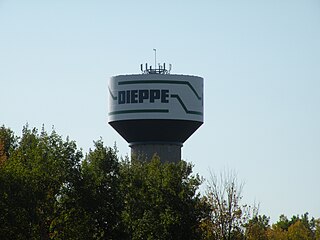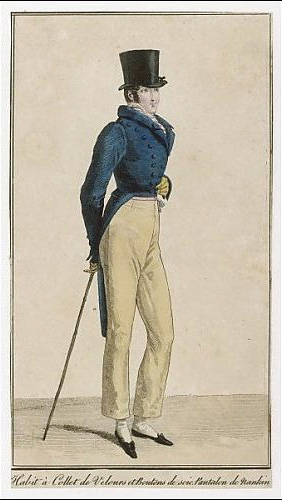Related Research Articles

Crochet is a process of creating textiles by using a crochet hook to interlock loops of yarn, thread, or strands of other materials. The name is derived from the French term crochet, meaning 'hook'. Hooks can be made from a variety of materials, such as metal, wood, bamboo, or plastic. The key difference between crochet and knitting, beyond the implements used for their production, is that each stitch in crochet is completed before the next one is begun, while knitting keeps many stitches open at a time. Some variant forms of crochet, such as Tunisian crochet and broomstick lace, do keep multiple crochet stitches open at a time.

A peasant is a pre-industrial agricultural laborer or a farmer with limited land-ownership, especially one living in the Middle Ages under feudalism and paying rent, tax, fees, or services to a landlord. In Europe, three classes of peasants existed: slave, serf, and free tenant. Peasants might hold title to land either in fee simple or by any of several forms of land tenure, among them socage, quit-rent, leasehold, and copyhold.

The Huguenots were a religious group of French Protestants who held to the Reformed, or Calvinist, tradition of Protestantism. The term, which may be derived from the name of a Swiss political leader, the Genevan burgomaster Bezanson Hugues (1491–1532?), was in common use by the mid-16th century. Huguenot was frequently used in reference to those of the Reformed Church of France from the time of the Protestant Reformation. By contrast, the Protestant populations of eastern France, in Alsace, Moselle, and Montbéliard, were mainly Lutherans.

Lace is a delicate fabric made of yarn or thread in an open weblike pattern, made by machine or by hand. Generally, lace is divided into two main categories, needlelace and bobbin lace, although there are other types of lace, such as knitted or crocheted lace. Other laces such as these are considered as a category of their specific craft. Knitted lace, therefore, is an example of knitting. This article considers both needle lace and bobbin lace.

Dieppe is a city in the Canadian maritime province of New Brunswick. Statistics Canada counted the population at 28,114 in 2021, making it the fourth-largest city in the province. On 1 January 2023, Dieppe annexed parts of two neighbouring local service districts; revised census figures have not been released.

Dieppe is a coastal commune in the Seine-Maritime department in the Normandy region of northern France.

Operation Jubilee or the Dieppe Raid was an Allied amphibious attack on the German-occupied port of Dieppe in northern France, during the Second World War. Over 6,050 infantry, predominantly Canadian, supported by a regiment of tanks, were put ashore from a naval force operating under protection of Royal Air Force (RAF) fighters.

Espadrilles are casual, rope-soled, flat but sometimes high-heeled shoes. They usually have a canvas or cotton fabric upper and a flexible sole made of esparto rope. The esparto rope sole is the defining characteristic of an espadrille; the uppers vary widely in style.

Alençon lace or point d'Alençon is a needle lace that originated in Alençon, France. It is sometimes called the "Queen of lace." Lace making began in Alençon during the 16th century and the local industry was rapidly expanded during the reign of Louis XIV by Jean-Baptiste Colbert, who established a Royal Workshop in the town to produce lace in the Venetian style in 1665. The purpose of establishing this workshop was to reduce the French court's dependence on expensive foreign imports. Marthe La Perrière had modified the Venetian technique and Alençon emerged as a unique style around 1675 after Colbert's monopoly ended. The lace employs a mesh ground and incorporates pattern motifs with a raised outline of closely packed buttonhole stitches, an outer edge decorated with picots, and open areas with decorative fillings.

Limerick lace is a specific class of lace originating in Limerick, Ireland, which was later produced throughout the country. It evolved from the invention of a machine which made net in 1808. Until John Heathcoat invented a net-making machine in Devon in 1815, handmade net was a very expensive fabric. This meant cheap net became available to Irish lacemakers, particularly after 1823 when Heathcoat's patent expired.

Antwerp lace is a bobbin lace distinguished by stylized flower pot motifs on a six point star ground. It originated in Antwerp, where in the 17th century an estimated 50% of the population of Antwerp was involved in lace making. Antwerp lace is also known, from its familiar repeated motif, as Pot Lace— in Dutch Pottenkant or Potten Kant. It is sometimes said that the flowers were a depiction of the Annunciation lilies; however, the flowers were not limited to lilies.

The theory of Portuguese discovery of Australia claims that early Portuguese navigators were the first Europeans to sight Australia between 1521 and 1524, well before the arrival of Dutch navigator Willem Janszoon in 1606 on board the Duyfken who is generally considered to be the first European discoverer. While lacking generally accepted evidence, this theory is based on the following:

Nankeen is a kind of pale yellowish cloth originally made in Nanking, China from a yellow variety of cotton, but subsequently manufactured from ordinary cotton that is then dyed.

"Immaculate Mary" or "Immaculate Mother" is a popular Roman Catholic Marian hymn. It is also known as the Lourdes Hymn, a term which also refers to the hymn tune itself. It is often sung in honour of the Immaculate Conception of the Blessed Virgin Mary.

Lace machines took over the commercial manufacture of lace during the nineteenth century.

Point de Paris is a French bobbin lace of the 18th century, with slender trailing designs in a point de Paris ground. It was a simple lace, and did not compete with those of Flanders. It was revived in the late 19th century for trimming lingerie and 'fancy linen'.

Portrait of Catharina Brugmans is an oil-on-canvas painting by the Dutch Golden Age painter Frans Hals, painted in 1634 and now in a private collection. It is considered a pendant to the portrait of Catharina's husband Tieleman Roosterman.
Margaret Roscoe was an early 19th-century English botanical illustrator and author. She was a mother to Margaret Sandbach and wife to Edward Roscoe.

The Leavers machine is a lacemaking machine that John Levers adapted from Heathcoat's Old Loughborough machine. It was made in Nottingham in 1813. The name of the machine was the Leavers machine. The original machine made net but it was discovered that the Jacquard apparatus could be adapted to it. From 1841 lace complete with pattern, net and outline could be made on the Leavers machine.

Herbert Niebling was a master designer of the style of lace knitting called Kunststricken (art-knitting). Today, his designs remain popular with lace knitting enthusiasts.
References
- ↑ French lace, Lace of France
- ↑ Page 116: Ave Maria lace History of Hand-Made Lace [ dead link ] Archived, ...Bobbin lace of a simple Valenciennes variety. The ground is plaited. It is chiefly made at Dieppe by the peasants, who have given it its special name...
- ↑ https://www2.cs.arizona.edu/patterns/weaving/books/pbm_lace_4.pdf [ bare URL PDF ]
- ↑ A History of Lace By Bury Palliser
- ↑ Lace: Its Origin and History, By Samuel L. Goldenberg
- ↑ A History of Hand-Made Lace, By M.F. Jackson, Page 149
